DiskBoss recognizes more than 3,500 types of files and is capable of classifying files and showing a categorized hierarchy of files sorted
by the amount of the disk space used by each file category. DiskBoss includes a number of file classification plugins capable of classifying
files by the file type, extension, user name, last access, modification and creation dates, etc. In order to classify files in one or more
disks or directories, select the required directories in the DiskBoss file navigator and press the 'Classify' button.
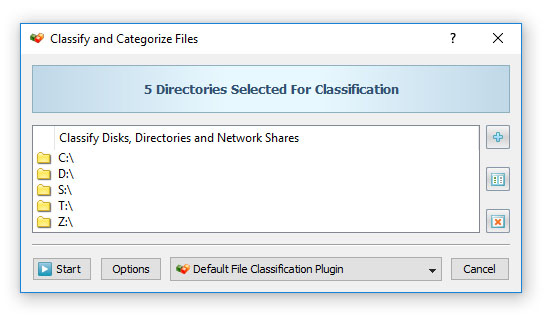
On the 'File Classification Plug-ins' dialog, select an appropriate file classification plug-in and press the 'Classify' button. DiskBoss
will classify all the selected disks and directories and show the file classification results dialog displaying a categorized hierarchy
of files sorted by the amount of the disk space used by each file category.
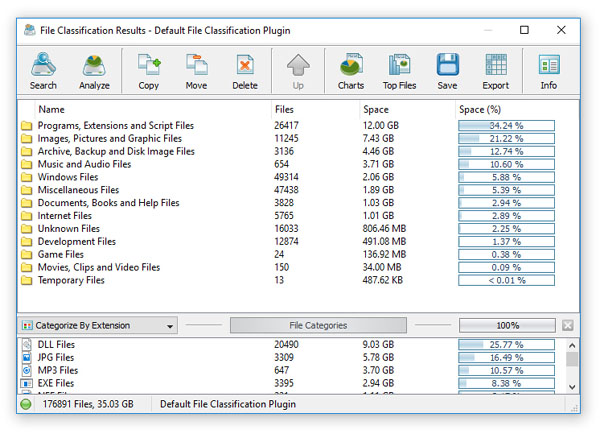
The file classification results dialog allows one to browse the file hierarchy, perform file management operations on files and file categories,
generate various types of charts, export HTML, PDF, Excel, XML, text and CSV reports and submit file classification results to an SQL database.
In addition, the user is provided with the ability to physically reorganize files on the disk according to the used file classification plug-in.
Finally, power users are provided with the ability to design custom plug-ins using an open and easy-to-use XML-Based format.
File Filters and File Categories
The top view of the file classification results dialog shows the file categories and classes sorted by the amount of the used disk space and
the bottom view shows the second-level file categories and filters, which may be used to filter files and categories displayed in the top
view making it very easy to focus on specific types of files or file groups.
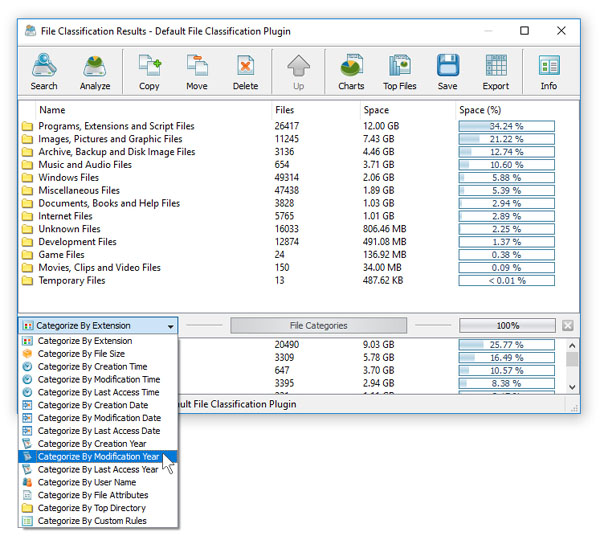
DiskBoss allows one to categorize file classification results by the file extension, file size, user name, creation, last modification and
last access dates. In order to change the current file categorization mode, click on the file categorization combo box located in the
top-left corner of the second-level file categories view.
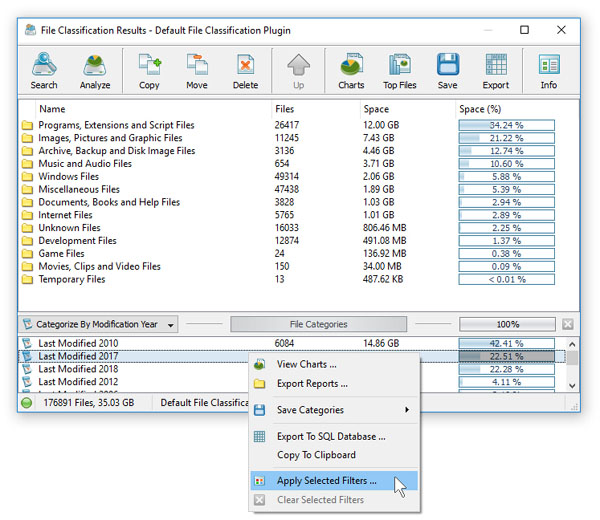
In order to apply a second-level file filter, select one or more file categories in the filters view, press the right mouse button and select
the 'Apply Selected Filters' menu item. DiskBoss will filter file classification results and display in the top view files matching the selected
file filters and file categories containing these files.
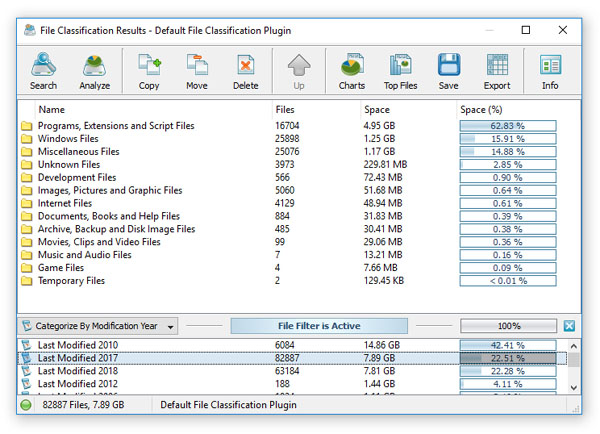
When a file filter is active, the file classification results dialog generates charts and exports HTML, PDF, XML, text and Excel CSV reports
for filtered files only. The user is provided with the ability to browse the filtered file hierarchy and perform file management operations
in the usual way. In order to reset the file filter, press the right mouse button over the filters view and select the 'Clear Selected Filters' menu item.
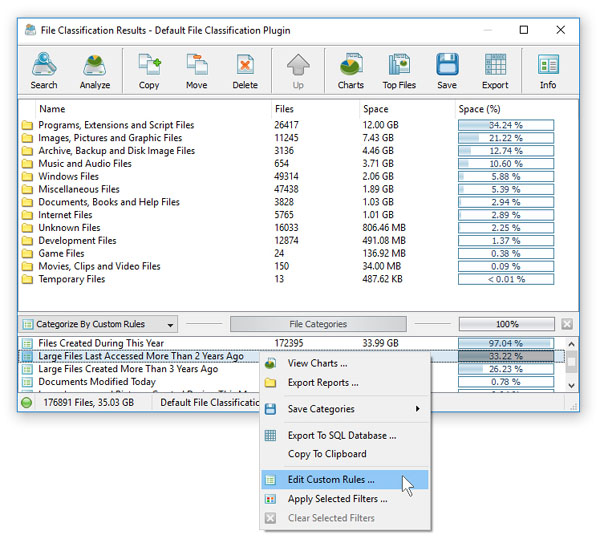
In addition to the built-in file filters, DiskBoss provides the ability to pre-configure one or more custom file filters according to user-specific
needs and requirements and then categorize and filter the file classification results using to the user-custom file filters. In order to add a custom
file filter, select the custom file filters view, press the right mouse button over the filters view and select the 'Edit Custom Rules' menu item.

In order to add a new custom file filter, press the 'Add' button, enter a unique filter name and configure one or more file matching rules specifying
which types or groups of files to display. In order to edit a custom file filter, select the filter in the custom file filters dialog and press the 'Edit' button.

Once finished configuring custom file filters, close the filters dialog and DiskBoss will categorize the currently displayed file classification results
and show the list of user-specified custom file filters sorted by the amount of data and the number of files matching the specified file filters.
In order to filter the currently displayed file classification results by one or more custom file filters, select the required custom file filters
in the filters view, press the right mouse button and select the 'Apply Selected Filters' menu item. DiskBoss will filter the file classification
results according to the selected custom file filters and display the amount of data and the number of files matching the selected file filters.
File Classification Pie Charts
The DiskBoss file classification utility provides multiple types of statistical pie charts and timeline charts capable of showing the amount of disk space
usage and the number of files per file category, file extension, file size, file owner, creation, modification and last access time. In order to open the
charts dialog, press the 'Charts' button located on the file classification results dialog and select an appropriate chart type.
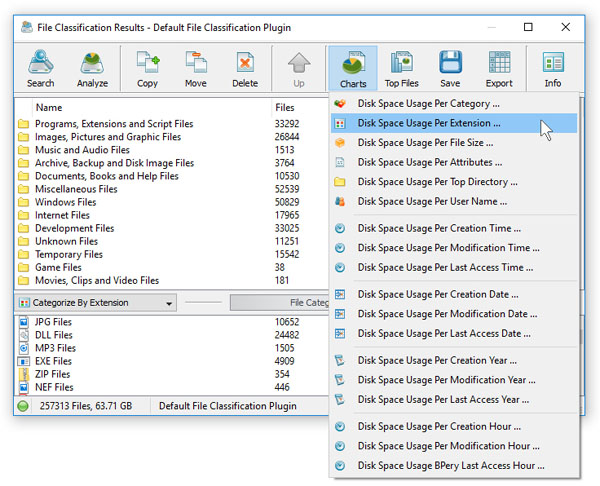
For example, in order to open a chart showing the disk space usage and the number of files per file category, press the 'Charts' button located on the
file classification results dialog and select the 'Disk Space Usage Per Category' chart type.
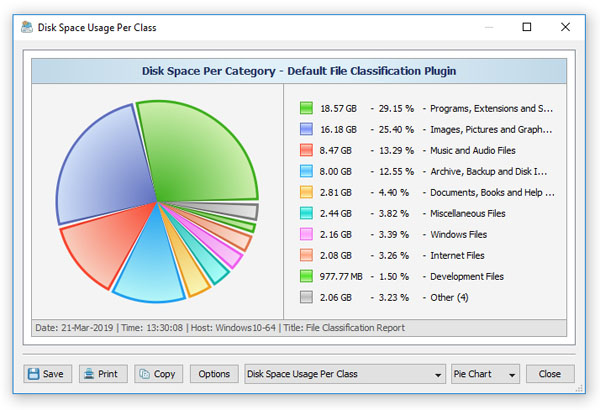
In addition, the charts dialog provides the user with the ability to export the chart data to a number of different formats, export the chart image
to the BMP, JPEG and PNG image files, and copy the displayed chart image to the clipboard allowing one to easily integrate DiskBoss charts into
user's documents and presentations. In order to customize the chart's description, press the 'Options' button and specify a custom chart title,
host name, date or time.
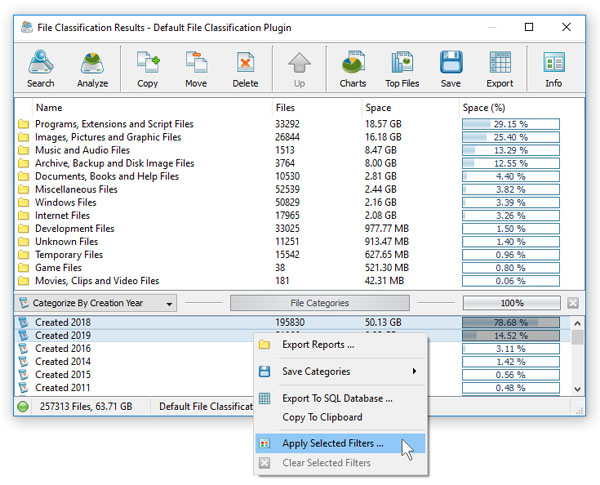
One of the most powerful features of the DiskBoss file classification utility is the ability to filter file classification results using one
or more user-specified filters and then categorize filtered results and display statistical pie charts. For example, in order to display
a pie chart showing the amount of disk space usage per file extension for files that were modified during the last two years, set the file
categorization mode to 'Categorize By Modification Year', select one or more years to show the information for, press the right
mouse button over the file filters view and select the 'Apply Selected Filters' menu item.
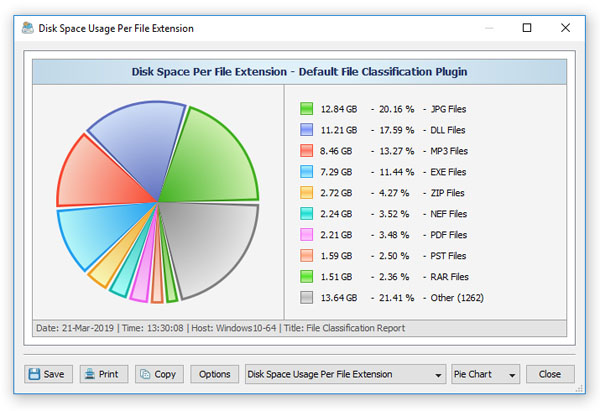
DiskBoss will filter the file classification results and display files that were modified during the selected years. Now, press the 'Charts' button
located on the file classification results dialog and select the 'Disk Space Usage Per Extension' menu item. DiskBoss will categorize the filtered
file classification results and display a pie chart showing the amount of disk space usage per file extension for files that were modified
during the selected years. In a similar way, the user can filter file classification results by the file type, size, user name, file attributes,
creation, modification and last access dates and then display various types of charts showing the disk space usage or the number of files
according to user-specific needs.
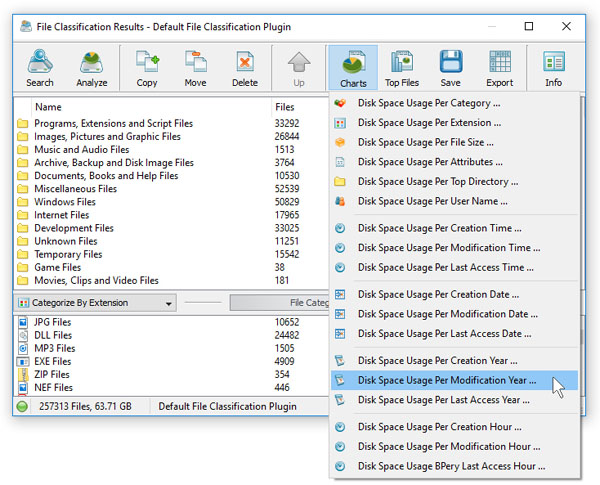
Another powerful capability is the ability to display the disk space usage timeline charts for all or filtered file classification results.
In the simplest case, press the 'Charts' button located on the file classification results dialog and select the 'Disk Space Usage Per Modification Year' menu item.
DiskBoss will display a time line chart showing how much data was modified per year. In order to display how many files were modified per year,
set the chart mode to 'Number Of Files Per Modification Year'.
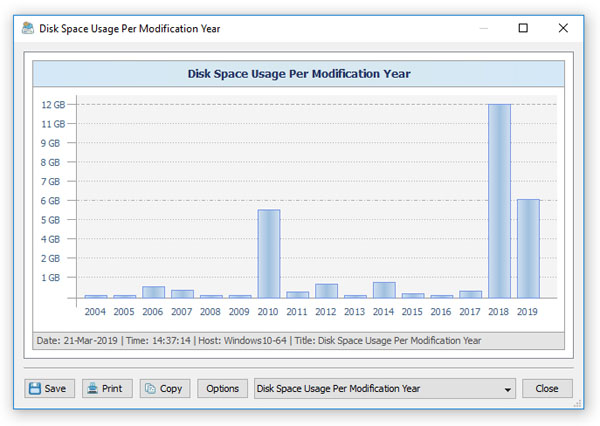
In addition, the user is provided with the ability to display timeline charts for filtered file classification results. For example, in order
to display how many documents were created per year, set the file categorization mode to 'Categorize By File Type', select
the 'Documents, Books and Help Files' file category, press the right mouse button and select the 'Apply Selected Filters' menu item.
Now, press the 'Charts' button located on the main toolbar, and select the 'Disk Space Usage Per Creation Year' menu item.
Analyzing File Classification Results
DiskBoss provides multi-level file classification and disk space analysis capabilities allowing one to analyze file classification results and visualize
physical locations of all files related to one or more specific file categories or file classes. These capabilities are especially useful when used
in conjunction with second-level file categories and filters providing the user with the ability to analyze categorized and filtered file classification
results and making it very easy to reveal locations of very specific files the user is looking for.
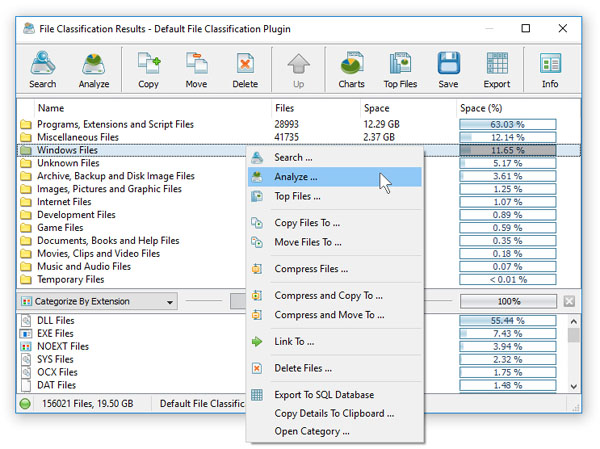
In order to analyze file classifications results, select one or more file classes or categories in the file classification results dialog, press the
right mouse button and select the 'Analyze' menu item. DiskBoss will process the selected file categories and classes and display a file system hierarchy
showing files related to the selected file categories or classes and the directories containing these files.
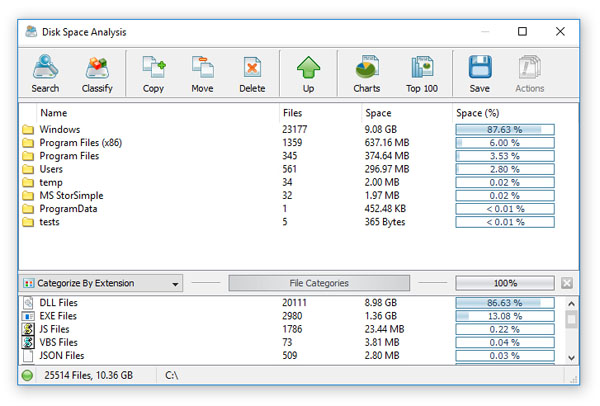
Analysis results are displayed in the standard disk space analysis dialog, which provides the user with the ability to generate pie charts, export HTML,
PDF, XML, text and Excel CSV report, perform file management operations, etc.
Searching Files in File Classification Results
DiskBoss provides the ability to search files in file classification results by the file name, extension, full path, file category, file size, file attributes,
creation, last modification and last access dates. In order to start a file search operation, classify one or more disks or directories and press
the 'Search' button located on the main toolbar.
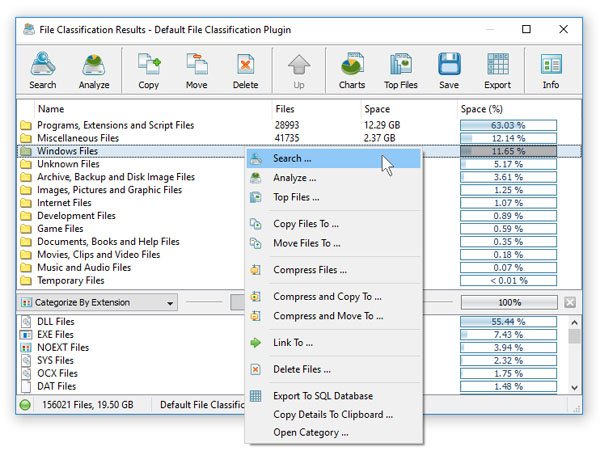
By default, the search operation will be performed on all file classification results. In order to search files in a specific file category, select the category
in the file classification results view, press the right mouse button and select the 'Search Files' menu item. DiskBoss will search in the selected categories
of files and display the file search results dialog showing a list of files matching the user specified criteria.

The search results dialog allows one to filter and categorize file search results, display various types of pie charts, copy, move and/or delete files,
export file search results to a number of standard report formats including PDF, HTML, text, Excel CSV and XML. In addition, advanced users are provided
with the ability to export file search results to an SQL database.
File Management Operations
DiskBoss allows one to copy, move and delete files and related to specific file categories. In order to perform a file operation on one or more file
categories, select the required items in the file categories view, press the right mouse button and select an appropriate file management operation.
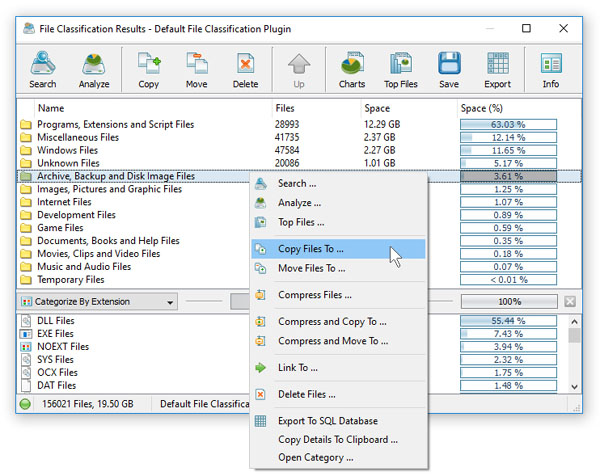
For copy and move operations, enter the destination directory and optionally press the 'Advanced Options' button to open the file copy options dialog.
The copy options dialog allows one to control the file overwrite mode, file copy rules, performance tuning options and error handling options.
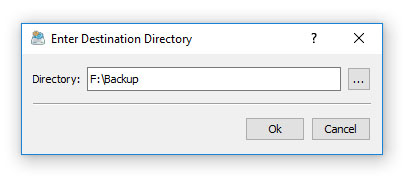
When copying files with an active file filter, DiskBoss automatically adds one or more file matching rules to the 'Rules' tab ensuring that only filtered
files are copied to the destination directory. In order to delete files related to one or more file categories, select the required file categories
in the categories view, press the right mouse button and select the 'Delete' menu item.
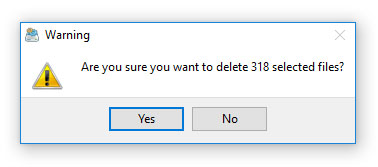
For example, in order to delete all types of document files, classify files in a disk or directory using the default file classification plug-in, select
the 'Document Files' file category in the file classification results view, press the right mouse button and select the 'Delete' menu item.
File Classification Reports
DiskBoss allows one to save file classification reports into a number of standard formats including HTML, PDF, Excel, XML, text and CSV. In the simplest case,
perform a file classification operation and press the 'Save' button located on the file classification results dialog. On the save report dialog, select
an appropriate report format, enter a report file name and press the 'Save' button.
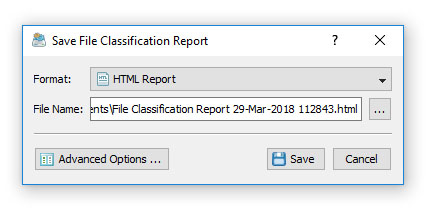
For the HTML, PDF, text, Excel CSV and XML report formats, the user is provided with the ability to save a short summary report or a longer detailed report,
which may be very long for large file systems containing millions of files. By default, DiskBoss will save a short, summary file classification report
in the HTML report format, which will include a list of top-level file categories according to the selected file classification plug-in and a list
of tables showing the disk space usage and the number of files per file extension, file attribute, user name, etc.
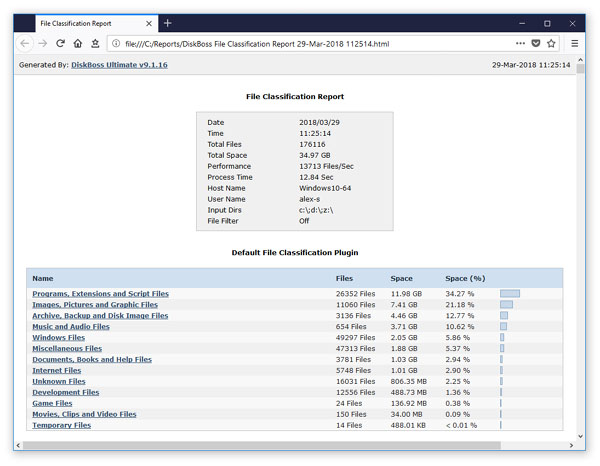
In addition, the user is provided with the ability to save file classification results to the DiskBoss native report format, which preserves all information
related to each specific file classification operation and may be loaded at any time just by clicking on a report file in the DiskBoss file navigator.
Microsoft Excel Reports
Sometimes, it may be required to perform additional analysis of file classification results using external tools such as Microsoft Excel. In order to export
file classification results to the Excel report format, perform a file classification operation, press the 'Save' button located on the file classification
results dialog, select the 'Excel Summary' report format for a short summary report or the 'Excel Report' format for a detailed file classification report.
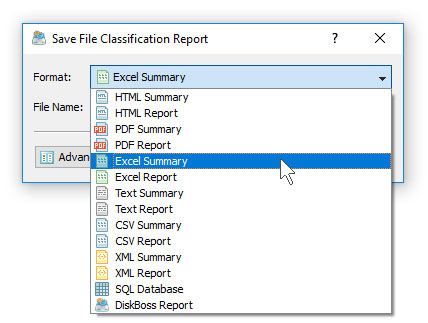
A summary Excel report will include a list of top-level file categories and a number of tables showing the used disk space and the number of files per file extension,
file attribute, file creation time, last modification time, user name, etc.
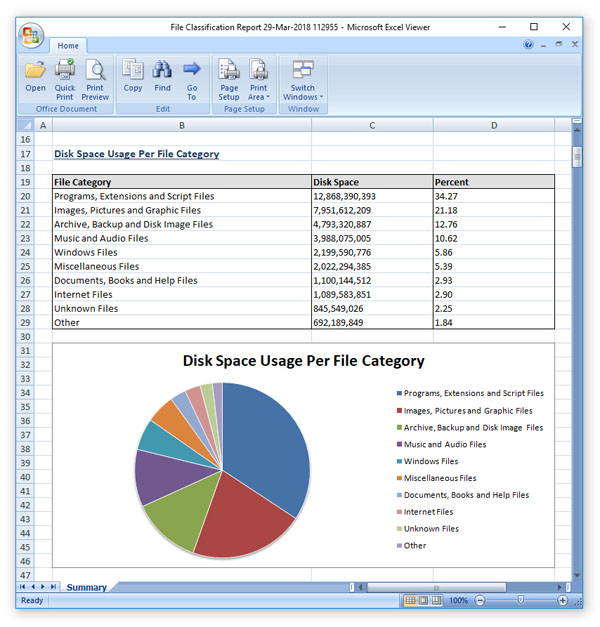
A detailed Excel report will include a list of file categories according to the currently selected file categorization mode and an hierarchy of file groups and file
classes sorted by the amount of the used disk space, which may be very long for large file systems containing millions of files. In order to control how many
hierarchy levels and how many files per level are exported in the detailed report, press the 'Advanced Options' button located on the 'Save Report' dialog
and customize the file classification report according to your specific needs.
Graphical PDF Reports
One of the most useful ways to export file classification results is to use the PDF summary or the PDF report formats. Both of these report formats include various
types of graphical pie charts showing disk space usage and the number of files per file extension, file category, creation time, last modification time, user name,
etc. In order to save file classification results to a PDF report file, press the 'Save' button located on the file classification results dialog and select
the 'PDF Summary' report format for a short, summary report or the 'PDF Report' format for a detailed file classification report.
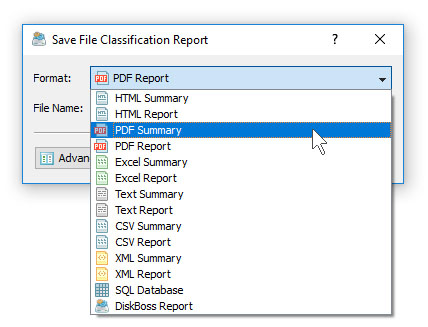
A summary PDF report will include a list of top-level categories of files according to the selected file classification plug-in sorted by the amount of the used
disk space followed by a number of pie charts showing the disk space usage and the number of files per file extension, file attribute, file creation time, last
modification time, user name, etc. A detailed PDF report will include an hierarchy of file groups and file classes sorted according to the used disk space,
which may be very long for large file systems containing millions of files.
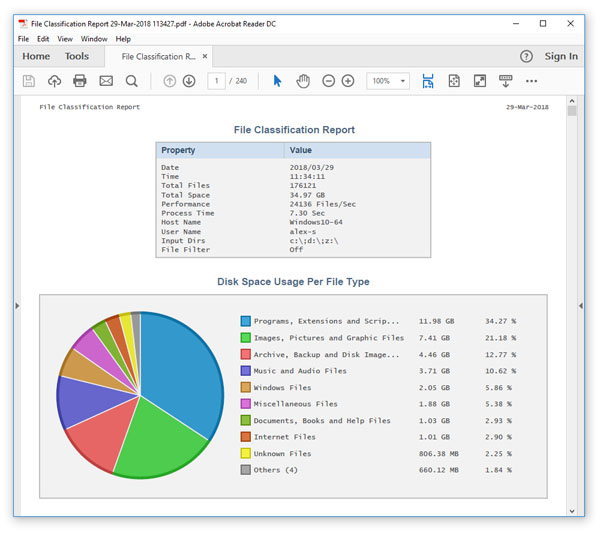
In addition to the hierarchy of file types sorted by the used disk space, detailed PDF reports include pie charts showing the disk space usage per file category
and the number of files per file category according to the currently selected file categorization mode. For example, if the second-level file categories mode
is set to categorize file classification results by the file extension, the PDF report will display pie charts showing the used disk space and the number
of files per file extension.
Batch File Classification Reports
DiskBoss allows one to save batches of file classification reports according to the currently selected categories of files with each report showing the disk
space usage and the number of files for a corresponding category of files. For example, let's assume that we need to save file classification reports for
the last 10 years with each report showing categories of files and the disk space usage for all files that were created during each year.
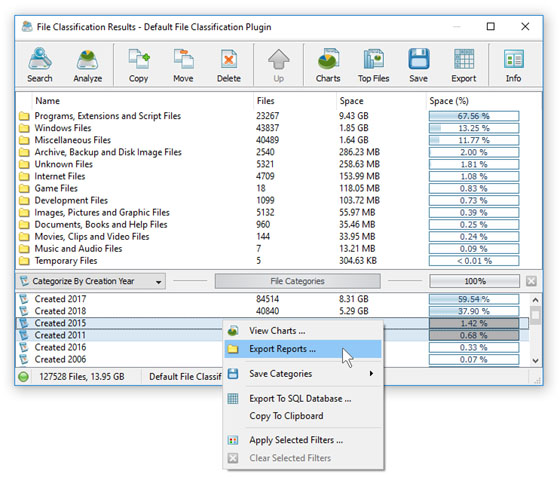
In order to generate such reports, set the file categorization mode to 'Categorize By Creation Year', select all years for which you need to generate analysis
reports in the file categories view, press the right mouse button and select the 'Export Reports' menu item. On the 'Export Reports' dialog, select an appropriate
report format and report mode, specify a destination directory to export reports to and press the 'Save' button.

For each selected year, DiskBoss will filter file classification results by the file creation year and save an individual file classification report in the specified
destination directory with each report file name and report title containing the file creation year.
In the same way, the user can generate batches of analysis reports showing categories of files and the disk space usage per user, last modification date, last access date,
file attributes, file size, top directory or user-custom categories pre-configured using flexible file matching rules.
For example, in order to export individual file classification reports for all users, set the file categorization mode to 'Categorize By User Name', select all the
required users, press the right mouse button and select the 'Export Reports' menu item. Now, the destination directory will contain a series of file classification
reports with each report showing categories of files and the disk space usage per user.
The batch reports dialog provides the ability to export reports to a number of standard report formats including: HTML, PDF, Excel, text, CSV and XML. Depending on
the selected report format and report mode, each report will include a summary table showing statistics about the report, a table showing categories of files sorted
by the amount of used disk space and lists of files for each category sorted by the file size.
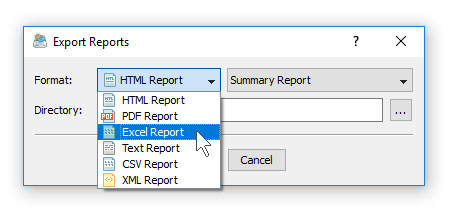
In addition, the batch reports dialog allows one to select one of the following report modes: summary report, compact report or full report. When the summary report
mode is selected, each report will include a summary table and lists of file categories sorted by the amount of used disk space. When the compact report mode is selected,
each report will include a summary table, lists of file categories and lists of top 100 files per file category. When the full report mode is selected, each report will
include a summary table, lists of file categories and full lists of files per category sorted by the file size.

Once the export operation will be completed, the specified destination directory will contain a number of file classification reports according to the selected file
categorization mode, selected categories of files and the selected report format.
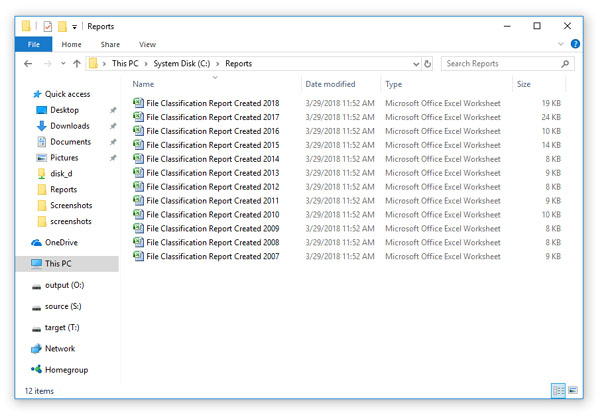
Exporting Reports to an SQL Database
IT professionals and storage administrators are provided with the ability to submit file classification reports from multiple servers and desktop
computers to a centralized SQL database. A long-term history of file classification reports allows one to gain an in-depth visibility into disk
usage trends across the entire enterprise. In order to submit a file classification report to an SQL database, select the 'SQL Database' report
format and press the 'Save' button.
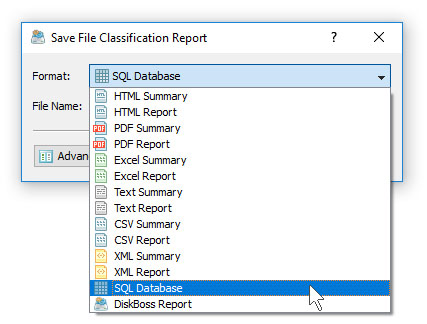
Before exporting reports to an SQL database, open the 'Options' dialog, enable the ODBC interface and specify the name of the data source,
database user name and password to use to connect to the database.
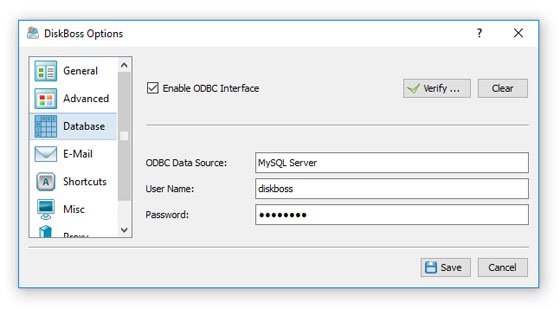
For each report in the database, DiskBoss displays the report date and time, the host name, the input directories, the total number of files
and disk space and the report title. To open a previously saved report, just click on the report item in the database reports dialog.
Comparing File Classification Reports
One of the most useful features of DiskBoss Server is the ability to compare file classification reports saved in the DiskBoss reports database
allowing one to easily identify how the disk space usage is changing over time. For example, the user can schedule a periodic file classification
operation to be performed once per week and then compare two weekly file classification reports and see what exactly changed over the time.
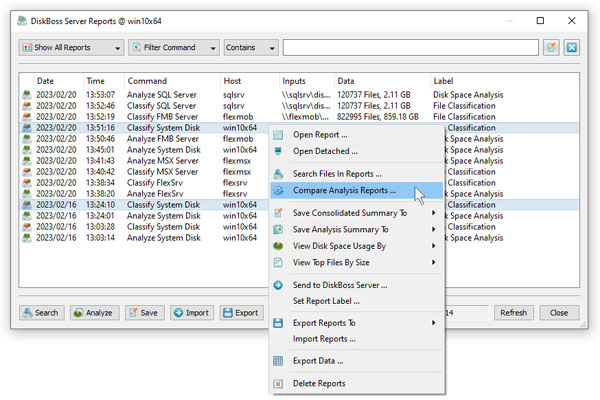
In order to compare file classification reports, press the 'Reports' button located on the main toolbar, select two file classification reports,
click the right mouse button and select the 'Compare File Classification Reports' menu item. DiskBoss Server will compare the selected file
classification reports and display the change report dialog showing a list of changes in the disk space usage and/or the number of files
per file category according to the file classification plug-in used for this specific file classification operation.
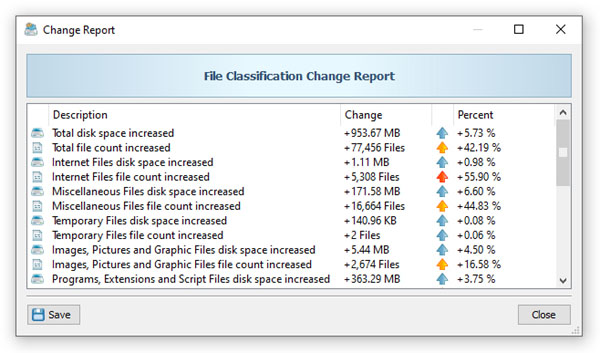
For example, if the file classification operation categorized files by the file type, the change report will show the changes in the disk space
usage and/or the number of files per file type. On the other hand, if the file classification operation categorized files per user, the change
report will display changes in the disk space usage and/or the number of files per user.
Analyzing Disk Space Usage Per Host
DiskBoss Server and DiskBoss Enterprise provide the ability to automatically detect all servers and NAS storage devices on the network,
classify files in hundreds of servers and/or NAS storage devices via the network, submit reports to the reports database and display charts
showing the disk space usage per server or NAS storage device across the entire enterprise.
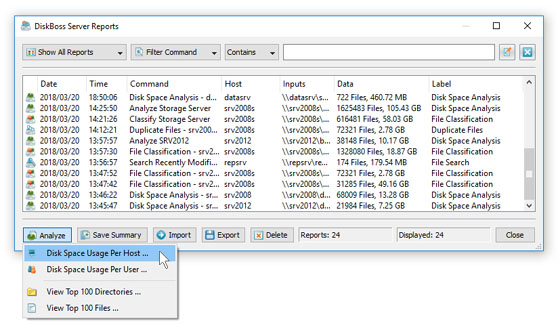
In order to analyze disk space usage per server, perform one or more file classification operations on multiple servers and/or NAS storage devices,
open the 'Reports' dialog, press the 'Analyze' button and select the 'Analyze Disk Space Usage Per Host' menu item. DiskBoss will analyze all reports
saved in the reports database and display the hosts analysis dialog showing the disk space usage per host.
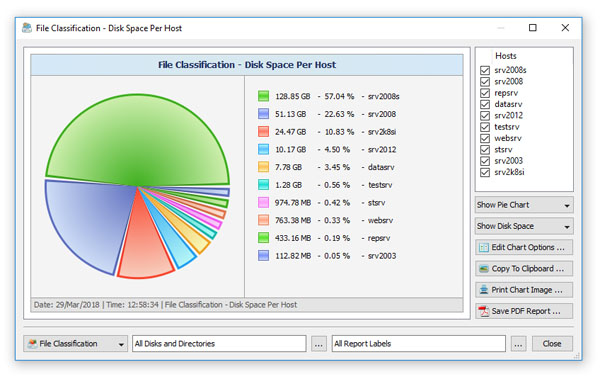
The hosts analysis dialog provides the ability to display pie charts and bars charts showing the disk space usage per server or NAS storage device
according to file classification reports saved in the reports database. The user is provided with the ability to select the types of file classification
operations and file system locations to analyze, edit the chart header and footer, copy the chart image to the clipboard and export graphical
PDF reports including pie charts.
Analyzing Disk Space Usage Per User
DiskBoss Server and DiskBoss Enterprise provide the ability to automatically detect all servers and NAS storage devices on the network, classify files
in hundreds of servers and/or NAS storage devices via the network, submit file classification reports to the reports database and display charts
showing the used disk space per user across the entire enterprise.

In order to analyze disk space usage per user, perform one or more file classification operations on multiple servers and/or NAS storage devices, open
the 'Reports' dialog, press the 'Analyze' button and select the 'Analyze Disk Space Usage Per User' menu item. DiskBoss will analyze all reports saved
in the reports database and display the users analysis dialog showing the disk space usage per user.
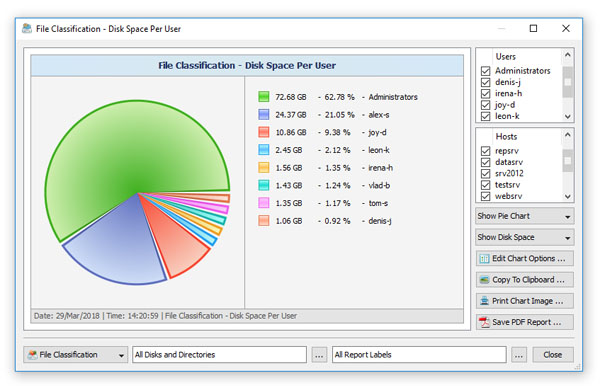
The users analysis dialog provides the ability to display pie charts and bars charts showing the disk space usage per user according to file classification
reports saved in the reports database. The user is provided with the ability to select the types of file classification operations and file system locations
to analyze, edit the chart header and footer, copy the chart image to the clipboard and export graphical PDF reports including pie charts.
IMPORTANT: In order to be able to display the disk space usage per user, the file classification operation should be configured to process and display files user names.
Classifying Files in Network Servers and NAS Storage Devices
DiskBoss allows one to scan the network, discover network servers and NAS storage devices, automatically detect all accessible network shares
and classify files in hundreds of network servers and NAS storage devices. In addition, the user is provided with the ability to export the list
of detected servers and NAS storage devices (including lists of network shares for each server) into HTML, PDF, text and Excel CSV reports.
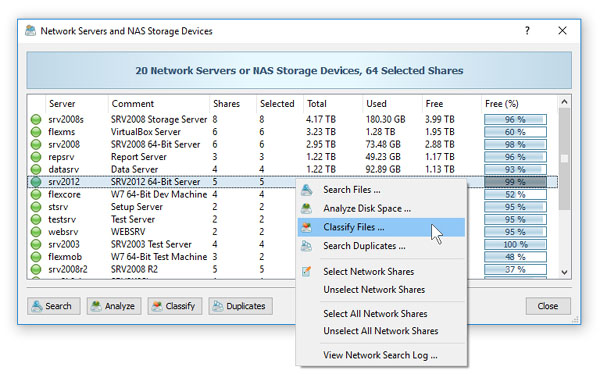
In order to discover all network servers and NAS storage devices on the network, press the 'Network' button located on the main toolbar and
wait while DiskBoss will scan the network and show a list of detected network servers and NAS storage devices. In order to classify files
in one or more servers or NAS storage devices, select the required servers and NAS storage devices and press the 'Classify' button.
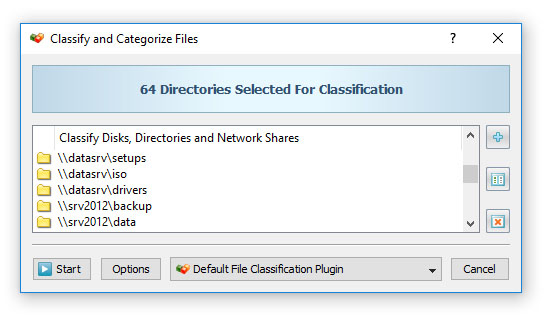
DiskBoss will show all accessible network shares hosted on the selected servers and NAS storage devices allowing one to classify files and save
various types of file classification pie charts and reports. In addition, the user is provided with the ability to customize a large number
of advanced file classification options allowing one to tune file classification operations for user specific needs and hardware configurations.
Batch File Classification Operations
DiskBoss Server and DiskBoss Enterprise provide the ability to execute one or more pre-configured file classification operations on all network
servers and NAS storage devices on the network and generate an individual file classification report for each server and NAS storage device.
In order to be able to use batch file classification operations, the user needs to pre-configure one or more file classification commands
customized to generate file classification reports according to user-specific needs and requirements.

In order to start a batch file classification operation, press the 'Network' button located on the main toolbar, search all servers and NAS storage
devices on the network, select one or more servers and NAS storage devices, press the right mouse button and select the 'Execute Batch Command' menu item.

DiskBoss will display a list of pre-configured file classification commands allowing one to select one or more commands to be executed on all selected
servers and NAS storage devices. In addition, the user is provided with the ability to select how to save file classification reports - for each server
or for each network share. By default, all file classification reports will be saved in the DiskBoss internal reports database allowing one to open
each report, review results, generate various types of pie charts and export reports into a number of standard formats including HTML, PDF, text, Excel CSV and XML.
Classifying Specific File Types and File Groups
On of the most powerful capabilities of DiskBoss is the integration between file search and file classification capabilities allowing one to
classify files matching one or more user-specified rules. For example, the user is provided with the ability to classify files with the file
size greater than X MB that were last modified more than Y months ago or any other combination of user-specific file matching rules.
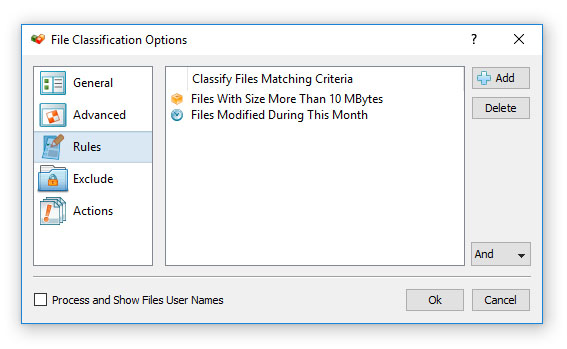
In order to add one or more file matching rules to a file classification operation, open the file classification options dialog, select
the 'Rules' tab and press the 'Add' button. Once finished adding file matching rules, select an appropriate rules logic mode (AND/OR) and
press the 'Ok' button. During the file classification process, DiskBoss will first evaluate all existing files using the specified file
matching rules and classify matching files only. Files not matching the specified rules will be just skipped from the file classification
process and not displayed in the file classification results dialog making it very easy to focus on files the user is looking for.
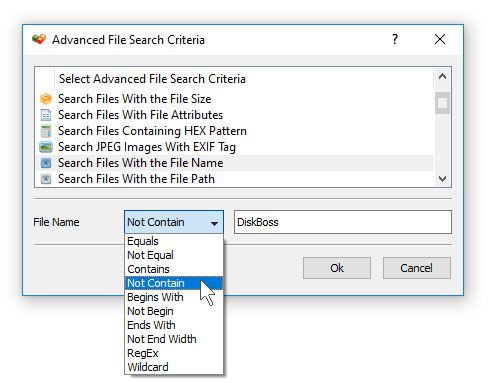
Another option is to exclude specific types of groups of files from the file classification process using one or more negative file matching
rules. For example, in order to exclude files with a specific text pattern in the file name, add a file name file matching rule, select
the 'Not Contain' rule operator and enter a text pattern to search for.
Excluding Subdirectories from File Classification Process
Sometimes, it may be required to exclude one or more subdirectories from the file classification process. For example, if you need to classify
files in a disk excluding one or two special directories, you may specify the whole disk as an input directory and add the directories
that should be skipped to the exclude list.
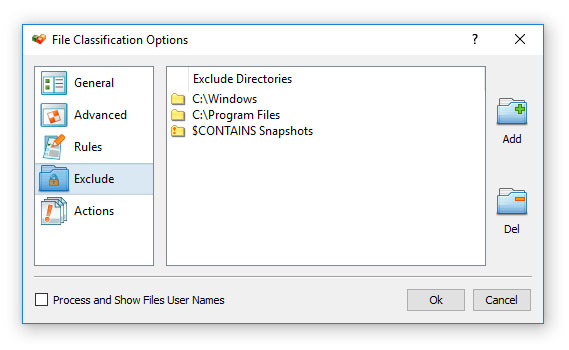
In order to add one or more directories to the exclude list, open the file classification command dialog, press the 'Options' button, select
the 'Exclude' tab and press the 'Add' button. All files and subdirectories located in the specified exclude directory will be excluded from
the file classification process. In addition, advanced users are provided with a number of exclude directories macro commands allowing
one to exclude multiple directories using a single macro command.
DiskBoss provides the following exclude directories macro commands:
- $BEGINS <Text String> - this macro command excludes all directories beginning with the specified text string.
- $CONTAINS <Text String> - this macro command excludes all directories containing the specified text string.
- $ENDS <Text String> - this macro command excludes all directories ending with the specified text string.
- $REGEX <Regular Expression> - this macro command excludes directories matching the specified regular expression.
- $DIRLIST <File Name> - this macro command excludes all directories listed in the user-specified text file.
- $FILELIST <File Name> - this macro command excludes all files listed in the user-specified text file.
For example, the exclude macro command '$CONTAINS Temporary Files' will exclude all directories with 'Temporary Files' in the full
directory path and the exclude macro command '$REGEX \.(TMP|TEMP)$' will exclude directories ending with '.TMP' or '.TEMP'.
Automatic File Organizing Operations
One of the most powerful capabilities of the DiskBoss file classification engine is the ability to physically organize files on the
disk according to the selected file classification plug-in. File organizing may be performed manually on file classification results
displayed in the file classification results dialog or automatically by selecting an automatic file organizing mode in the file
classification options dialog.
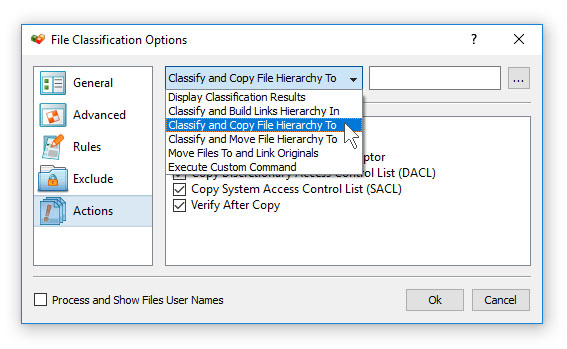
DiskBoss provides the user with the following advanced file organizing operations that may be performed on file classification results:
- Build Hierarchy of Links - in this mode DiskBoss will construct an organized hierarchy of directories and populate it with links to original files according to the selected file classification plug-in.
- Copy File Hierarchy - in this mode DiskBoss will construct an organized hierarchy of directories and populate it with copies of original files according to the selected file classification plug-in.
- Move File Hierarchy - in this mode DiskBoss will construct an organized hierarchy of directories and move all files into that hierarchy according to the selected file classification plug-in.
- Move Files and Link Originals - in this mode DiskBoss will construct an organized hierarchy of directories, move all files to that hierarchy according to the selected file classification plug-in and create links instead of original files pointing to files located in the organized file hierarchy.
- Execute Custom Command - in this mode DiskBoss will execute a custom command for each file passing the name of the file and the full file category as command line arguments allowing one to implement custom file organizing solutions.
By default, file classification results are displayed in the results dialog and the user is provided with the ability to perform these
operations manually by selecting one or more file categories or classes in the file classification results dialog.
In addition, power computer users and IT professionals are provided with the ability to physically reorganize files on the disk by using
one of the mentioned automatic file organizing modes. In an automatic file classification mode, DiskBoss will physically reorganize files
on the disk according to the selected file classification plug-in without showing the file classification results dialog.
Automatic file classification modes are especially useful in conjunction with the DiskBoss command line utility allowing one to perform
automatic file classification operations from shell scripts and batch files and integrate file classification capabilities in other products
and solutions. Finally, DiskBoss provides the user with the ability to design custom file classification plugins using an open and
easy-to-use XML-Based format making it possible to reorganize files into custom directory structures designed according to user-specific needs.
File Classification Plug-ins
By default, DiskBoss classifies and categorizes files using the 'Default File Classification Plug-in', which is capable of recognizing more
than 3,000 of the standard file types and formats and allows one to organize them into a logical file hierarchy. In addition, a number of
advanced file classification plug-ins are available for registered users of DiskBoss Ultimate and DiskBoss Server.
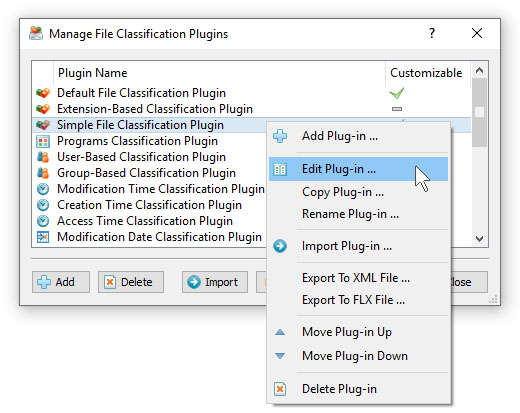
Finally, DiskBoss Ultimate provides the ability to add user-custom file classification plugins and customize the built-in file classification
plug-ins allowing one to classify and categorize files according to the user-specific needs and requirements. In order to add a custom file
classification plug-in, select the menu 'Tools - Manage Plugins', press the 'Add' button, specify a unique file classification plug-in name
and then use the file classification plug-in designer dialog to create your custom file categories and file classes.
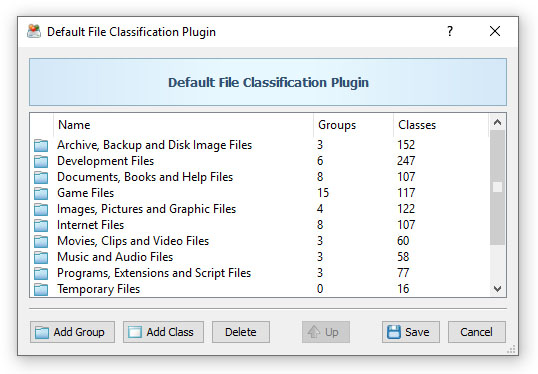
Another option is to customize a built-in file classification plug-in by adding support for one or more additional file type or file categories.
In order to customize a built-in file classification plug-in, select the menu 'Tools - Manage Plugins', select the required file classification
plug-in item, click the right mouse button and select the 'Copy Plug-in' menu, specify a new plug-in name and then double click on the newly
copied plug-in item to open the plug-in copy in the file classification plug-ins designer dialog.
Advanced File Classification Options
DiskBoss provides a large number of advanced file classification options allowing one to customize and configure file classification
operations for user-specific needs and custom hardware and storage configurations.
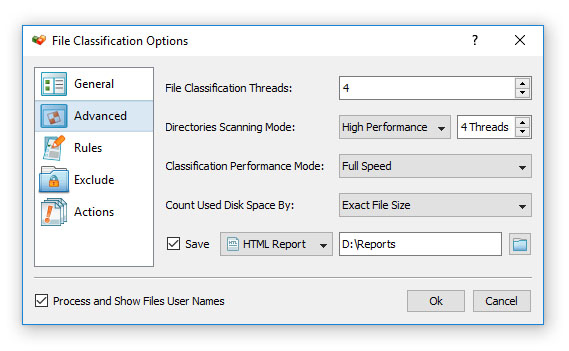
The file classification options dialog allows one to control the file scanning mode, the default report title, advanced reporting options,
the default file scanning filter and enable/disable automatic report generation. In addition, the user is provided with the ability to
classify specific file types, control performance tuning options, exclude specific directories from the file classification process
and physically reorganize files on the disk.
Pre-Configured File Classification Commands
One of the most powerful and flexible capabilities of DiskBoss is the ability to pre-configure custom file classification operations as
user-defined commands and execute such commands in a single mouse click using the DiskBoss GUI application or direct desktop shortcuts.
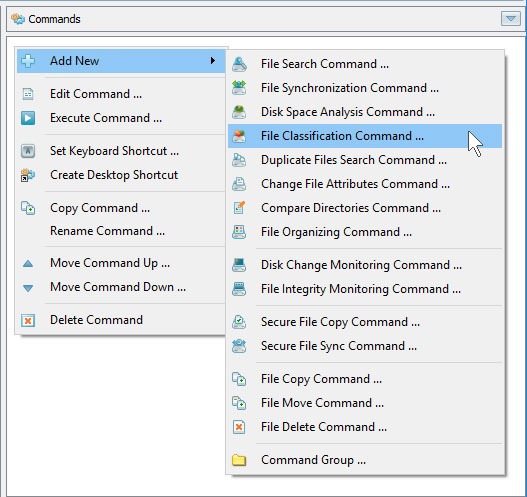
User-defined commands may be managed and executed through the commands dialog or the commands tool pane. In order to add a new command
through the commands pane, press the right mouse button over the pane and select the 'Add New - File Classification Command' menu item.
In order to execute a previously saved command, just click on the command item in the commands tool pane or create a direct desktop
shortcut on the Windows desktop.
Classifying Files Using DiskBoss Command Line Utility
In addition to the DiskBoss GUI application, DiskBoss Ultimate and DiskBoss Server provide a command line utility capable of performing file classification operations and
executing user-defined file classification commands from shell scripts and batch files. The DiskBoss command line tool is located in
the '<ProductDir>/bin' directory.
diskboss -classify -dir <Directory 1> [ ... <Directory X> <Options> ]
This command classifies files in the specified disks, directories or network shares.
diskboss -classify -server <Host Name 1> [ ... <Host Name X> <Options> ]
This command classifies files in all network shares in the specified servers.
diskboss -classify -network [ Options ]
This command classifies files in all network shares in all servers on the network.
diskboss -execute <User-Defined File Classification Command>
This command executes the specified user-defined file classification command.
Parameters:
-dir <Directory 1> [ ... <Directory X> ]
This parameter specifies the list of input disks or directories to classify. In order to ensure proper parsing of input directories,
directories containing space characters should be double quoted. By default, DiskBoss will generate a combined file classification
report showing information about all processed disks, directories and network shares. In order to generate an individual report for
each input directory, use the '-batch' command line option to enable the batch report generation mode.
-server <Host Name 1> [ ... <Host Name X> ]
This parameter specifies the list of host names or IP addresses of servers or NAS storage devices that should be classified. DiskBoss
will enumerate all network shares accessible in the specified servers or NAS storage devices, perform file classification and generate
reports if required. By default, DiskBoss will generate a combined file classification report showing information about all processed
network shares. In order to generate an individual report for each network share, use the '-batch' command line option to enable
the batch report generation mode.
-network
In the network-wide file classification mode, DiskBoss will discover servers and NAS storage devices accessible on the network, enumerate
all network shares available in all detected servers and NAS storage devices, perform file classification and generate reports if required.
By default, DiskBoss will generate a combined file classification report showing information about all processed network shares.
In order to generate an individual report for each network share, use the '-batch' command line option to enable the batch report generation mode.
Options:
-exclude_dir <Exclude Directory 1> [ ... <Exclude Directory X> ]
This option specifies the list of directories that should be excluded from the file classification operation. In order to ensure proper parsing
of command line arguments, directories containing space characters should be double quoted.
-save_html_report [ Report File Name ]
This option saves file classification results to an HTML report file. If no file name is specified, DiskBoss will automatically generate
a file name according to the following template: diskboss_[date]_[time].html and save a report file in the user's home directory.
-save_csv_report [ Report File Name ]
This option saves file classification results to an Excel CSV file. If no file name is specified, DiskBoss will automatically generate
a file name according to the following template: diskboss_[date]_[time].csv and save a report file in the user's home directory.
-save_text_report [ Report File Name ]
This option saves file classification results to a text report file. If no file name is specified, DiskBoss will automatically generate
a file name according to the following template: diskboss_[date]_[time].txt and save a report file in the user's home directory.
-save_pdf_report [ Report File Name ]
This option saves file classification results to a PDF report file. If no file name is specified, DiskBoss will automatically generate
a file name according to the following template: diskboss_[date]_[time].pdf and save a report file in the user's home directory.
-save_xml_report [ Report File Name ]
This option saves file classification results to an XML report file. If no file name is specified, DiskBoss will automatically generate
a file name according to the following template: diskboss_[date]_[time].xml and save a report file in the user's home directory.
-save_report [ Report File Name ]
This option saves file classification results to a native DiskBoss report file, which may be later loaded in the DiskBoss GUI application
for future review and analysis. If no file name is specified, DiskBoss will automatically generate a file name according to the following template: diskboss_[date]_[time].flr
-save_to_database
This option saves a file classification report to an SQL Database using the ODBC interface configured in the DiskBoss GUI application options dialog.
-title <Report Title>
This option sets a custom report title.
-label <Report Label>
This option sets a custom report label.
-levels <Class Hierarchy Levels>
This option sets the maximum number of class hierarchy levels to export.
-files_per_class <Files Per Class>
This option sets the maximum number of files per class to export (default is 20).
-compress
This option instructs to save compressed file classification reports.
-batch
This option enables the batch report generation mode. In the batch report generation mode DiskBoss saves an individual report file for each input disk, directory or network share.
-v
This option shows the product's major and minor versions.
-help
This option shows the command line usage information.

